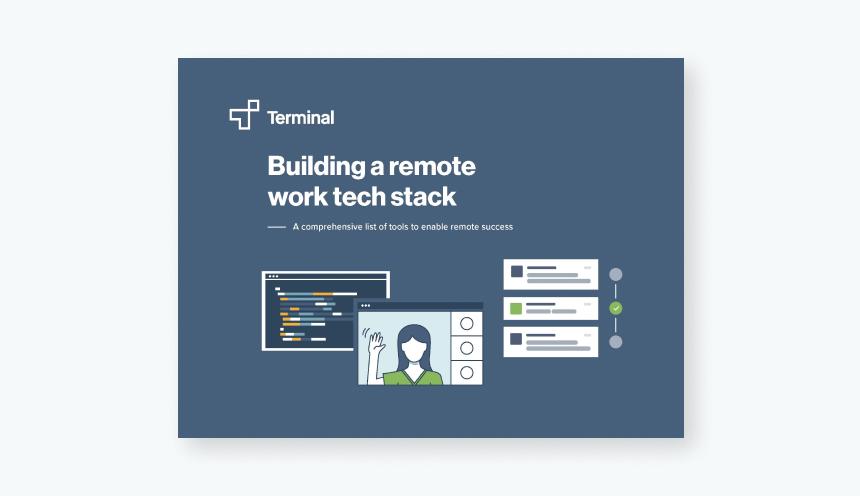
Remote how-to’s | Blog Post
6 Remote Team Insights from Stripe’s Head of Engineering for LatAm
Linzi Nield
Share this post
When it comes to remote work, Juan Pablo Buritica is a true expert. He built a completely distributed organization as part of his role as VP of Engineering at Splice. The Colombia native was recently hired to be Head of Engineering for Latin America at Stripe, where he’ll set up engineering infrastructure and assemble teams across the region.
“I’ve built distributed teams for about 10 years from New York City,” Buritica says. “I’m excited to help organizations build distributed engineering teams, and particularly build organizations and communities in Latin America. It holds a very special place in my heart.”
We recently sat down with Buritica as part of Terminal’s AMA series on Remote Work. Here are Buritica’s tips for creating and maintaining a remote team, in Latin America and beyond.
Remote work doesn’t require supervision
According to Buritica, one of the worst things you can do to remote employees is micromanage them. “The only way you can transcend distance and time separation is by trusting people,” he says.
He acknowledges that there’s a significant difference between mindfully setting up a distributed team and being stuck at home trying to get work done. In fact, Buritica says that a company’s level of micromanagement during the pandemic can be a good indicator of whether or not they’re ready to transition to remote work beyond shelter-in-place.
“I’ve already seen some companies adopt policies that monitor metrics like how many Zoom calls people have been on or how many emails they’ve sent in one day,” says Buritica. “Companies that believe that remote work requires supervision should not adopt remote work because they don’t understand that teams require trust.”
Buritica says that a trusting relationship starts from the outset. “When I hire a person, I set enough incentives and give them enough information to make sure we’re aligned when they are joining,” he says. “They joined because they presumably believe in what we’re doing. From there, we can cascade — here’s the direction of where we want to get to, here’s how we might or might not achieve our goals.
Align teams around quick goals that can be measured
Buritica advises that teams monitor the metrics that count. He recommends that organizations set quick goals that can be measured and to allow engineers, designers, and anyone else working towards those goals to take ownership of them. “In a distributed environment, if you own your goals and know what you’re trying to achieve, it enables you to work independently,” he says. “It enables you to take on responsibilities and do them whenever you want. It detaches you from time.”
To do this well requires a ton of work, and Buritica advises teams who are stuck to recognize that remote work is a process. “Right now, try to keep doing what you’re doing,” he says. “Perhaps you will have fewer meetings over time. Start with trying to move a lot of work to written artifacts, instead of having a Zoom call be the answer to everything.”
You don’t have to be in the same room with someone to figure out if you can work with them
Buritica encourages managers to let go of the idea that you need to conduct in-person interviews. “The only thing you find out from an in-person interview that you can’t find out remotely is a person’s height,” says Buritica. “I’ve heard people argue that they need to interview someone in person because hiring without meeting in person would be akin to marrying someone without meeting in person,” he says. But he’s sick of the comparison. “Please don’t use that analogy in a professional context. It’s not the same,” he says.
Instead, Buritica advises tailoring your interview to figure out how well someone can work remotely. “Try to adapt your hiring process to evaluate whether or not this person can work independently,” he says. “Are they a self-starter? Can they communicate well? Are they on board with the company mission and team goals?”
Transparency is key when hiring your first remote team member in a different time zone
Hiring the first remote employee outside of a team’s own time zone is a big step for a team. But sometimes the best way to figure out if you’re ready is just to try it. The important thing is to be transparent.
Buritica says that you should let the candidate know that they are going to act as a remote work guinea pig. “Tell the candidate, ‘You’d be the first person who would be outside our time zone and we’re not sure if we can make it work. But we’re interested in trying.’”
From there, you can partner with the person who is joining to make sure information is accessible. You might even make it part of their job description to document and address remote work issues and help pave the way for future employees that might be in different time zones. “Ask this person to pay attention to how decisions are made and how information is distributed. If everything always happens in meetings, then how do we distribute that information better in a way that’s independent of time? How do we sync when we aren’t in the same time zone?” says Buritica. “Then, when that feels stable, you can add more people to the pipeline.”
Look to Latin America to expand your remote work talent pool
Buritica’s speciality is assembling distributed teams in Latin America, which has emerged over the last decade to become one of the globe’s hottest centers for tech talent. “Expanding your candidate search to all over the world is cool, because you have access to a broader talent pool and more opportunities,” he says.
Using the term “Latin America” to describe such a large region can be misleading, as each country has a different way of doing business. “Latin America isn’t as cohesive as other regions like Europe or North America or even Asia Pacific. Every country has a radically different regulation and approach,” says Buritica.
Buritica advises anyone looking to hire in Latin America to seek communities around the tech they’re interested in. “There are incredible communities in Brazil, Chile, Argentina, all over Central America,” he says. “From there, you can start inquiring about their networks.”
Long term, he wants to see companies invest in building out engineering teams in the region, and that too often foreign companies simply aren’t interested in investing in talent and giving engineers more experience in making production-ready software that scales. “There are a lot of people who are very talented but who haven’t had the opportunity to solve very difficult engineering problems,” he says.
Find what works for your organization
Whatever your company decides to do, Buritica encourages you to find a solution that works for your own unique organization. There isn’t a one-size-fits-all approach, and while frameworks can be a guide, they should be adapted. “We probably obsess about frameworks too much in this industry,” he says. “Smart Goals, OKRs, Mission-Vision-Strategy… the list goes on.”
“I shy away from making recommendations without context,” he says. “For example, OKRs probably wouldn’t be a good framework for a small startup. They’d spend too much time working on what the OKRs should be, when in fact their organization might be too small to use them. These tools depend on your size, your stage, and what you’re trying to achieve.”
So then what should companies focus on? At the end of the day, it comes down to your objectives and how you can measure your progress. Says Buritica, “The important thing is: What are good goals and how should they be measured?”


